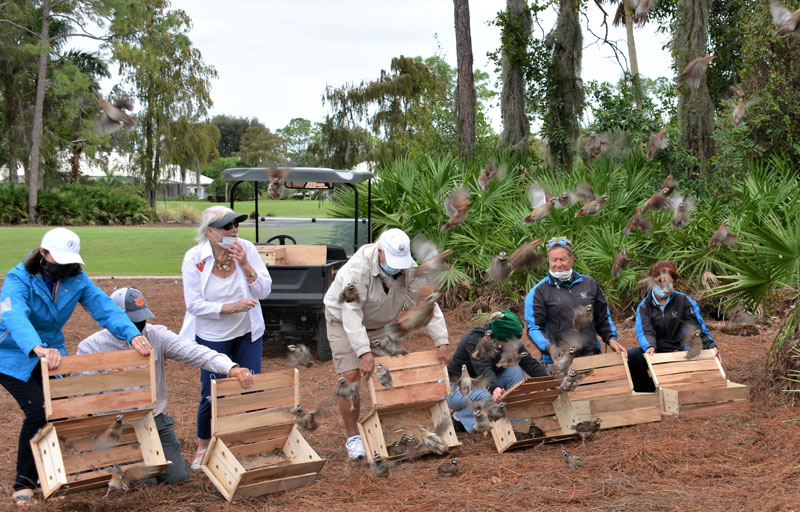
Volunteers release northern bobwhite quail onto the grounds of Quail Creek Country Club in Naples, Fla., in December 2020. Photo courtesy of Brian Beckner
Golf facilities often sport names that are naturally evocative, while others tend to slip into the realm of romanticized idyll.
The case of Quail Creek Country Club in Naples, Fla., is more of the former: Native quail did roam the grounds there before development disrupted or repurposed their habitat. Now, thanks to an unusual if not unique program of reintroduction, the northern bobwhite’s eponymous call might be heard regularly again.
Resident and board member Gary Evans recalled seeing coveys of native quail on the grounds decades ago. He approached Kevin Leo, Quail Creek’s director of golf courses and grounds and a 31-year GCSAA member, about the possibility of encouraging them to return.
As Evans set about fundraising, Leo reached out to Brian Beckner, a friend and former superintendent who just so happened to know a thing or two about birds.
Beckner, who had been a 19-year member of GCSAA before he left the industry to run what is now Native Bird Boxes, has since helped release 440 bobwhite quail into what was once their native habitat at Quail Creek.
“As of now,” Beckner says, “they’re surviving.”
Beckner released 220 of the birds, male and female, last March, and the same number again this past December. The hope, Beckner says, is that they’ll make themselves at home and, well, do that whole birds-and-bees thing.
Watch the December 2020 quail release at Quail Creek Country Club:
“We do still find them on the property,” Beckner says, “just not always where we put them. They are able to fly. Within 24 hours, we found some up to a half-mile to a mile from the club, some on the same property, some on the other side of it. We keep finding them in unique locations, but we’ve been unable to find a nest with eggs — so far.”
Back when he was approached about the idea, Beckner wasn’t sure whether he’d be able to find a source for the birds. He finally located a hatchery near Ocala. He knew there would be some losses.
“Are there going to be casualties with predators? Yes, we expect that,” he says. “Bobcats, raptors, feral cats ... those are some of the types of predators we have to worry about. Some people say, ‘All you’re doing is feeding wildlife.’ Well, those predators would be out there in the natural world anyway. Predation is to be expected. The hatchery says to expect 30% loss. Overall, 70% should be able to survive.”
The birds weren’t simply turned loose in the course’s native areas. To ensure they had food available, Leo’s team spread high-protein meal pellets — the same food the birds ate in the hatchery — in the native areas near their release that were most conducive to their establishment.
“We started with just the scent,” Beckner says. “We didn’t want to leave so much food that they wouldn’t start to (forage to) survive on their own, but we wanted to make sure they’d have something to eat.”
The jury’s still out on how successful the reintroduction will be. Golf courses have served as settings for the reintroduction of other native species — notably butterflies — but Beckner says it’s his understanding this is the first known attempt to reintroduce quail at a golf course.
Follow Native Bird Boxes on Twitter for regular updates about (and amazing photos from) Brian Beckner’s work with golf courses:
Beckner is uniquely positioned to understand both sides of the program. He had worked in the golf industry for more than 20 years when “the writing was on the wall” at the course where he served as superintendent.
In 2013, he took over Native Bird Boxes, primarily providing wooden birdhouses for golf courses. Long a fan of the game of golf and a bird lover since he was a child, Beckner seems perfectly suited for this line of work, which has expanded to include services that encompass all aspects of the feathered life cycle. Though it counts golf courses as about 90% of its clients, the clientele also includes communities seeking to increase opportunities for their fine, feathered friends along fitness trails and walking paths. Native Bird Boxes still sells birdhouses, too, but more importantly advises what birds are best suited where and just where those houses belong.
“There are so many layers involved,” Beckner says. “It’s this huge matrix to learn the nesting habits of each species, the migration, is it raptor season, is it migration season? That’s what so intrigued me.
“North America has 946 species available to be seen. I told myself, if I could touch the top 5% of people on golf courses who don’t believe in our urban green spaces and bring them to our side ... we’re not the Carl Spacklers of the 1980s,” Beckner says of the lovable but blunderingly clueless superintendent in the 1980 comedy “Caddyshack.” “We need to do all we can to make sure these species are there for our children.”
Brian Beckner of Native Bird Boxes chats with GCSAA TV about the benefits of on-course bird boxes — many golfers are birders too! — and shares five tips for establishing a bluebird house on your golf course:
Andrew Hartsock is GCM’s managing editor.